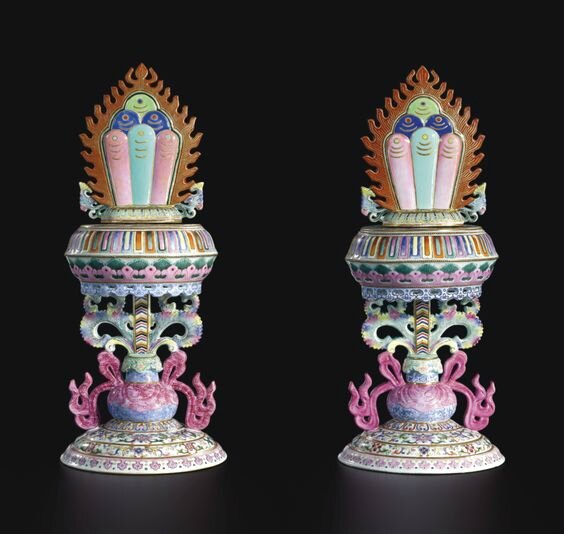A pair of famille-rose 'flaming pearl' altar ornaments, seal marks and period of Qianlong (1736-1795)
Lot 106. A pair of famille-rose 'flaming pearl' altar ornaments, seal marks and period of Qianlong (1736-1795). Estimate 1,800,000 — 2,500,000 HKD. Unsold. Photo: Sotheby's
each modelled as the 'flaming pearl' of the qizhengbao or qizhen ('Seven Royal Treasures') resting on an elaborate pedestal, the stylised emblem fashioned with a band of gilt-decorated iron-red flaming wisps surrounding multi-coloured lappets picked out with circular motifs and highlighted with gilt bands, all resting on an oval base flanked by a pair of foliate flanges, the base encircled with a lotus lappet border, the pedestal elaborately formed with a stylised top flaring out along the centre and decorated with bands of petal and foliate lappets, resting atop a shapely post modelled in openwork with a multi-coloured herringbone upright flanked by foliate scrolls, all stemming from a beribboned vase supported on a rounded stepped foot delicately rendered in registers with floral scrolls and petal lappets, the turquoise-enamelled base centred with an iron-red six-character seal mark within a white cartouche - 38 cm, 14 7/8 in.
Notes: The present altar emblem is a stylised representation of a flaming pearl which belongs to the ‘Seven Royal Treasures’ (qizhengbao or qizhen) of Buddhism, the other six comprised by a golden wheel (representing Buddhist doctrine), dark swift horses (facility in war and transportation), white elephants (sovereignty and great wealth), loyal generals (responsible for the welfare of the people), Ministers of the Treasury (who holds authority over the military troops to defend the borders from attack), and the lady (who serves as virtuous wife to the king). According to an Indian Buddhist myth, the ‘wheel turning sage king’ (cakravarti-raja) possessed the Seven Treasures, which would aid him in ruling his domain. Later, these seven treasures were inherited by Buddhism, which were said to have been brought to earth by the Universal Monarch, theChakravartin. These emblems were taken as offerings presented to Sakyamuni Buddha and symbolic of his pacifying and protective powers. Due to the emblems being associated with sage kings, with whom the Chinese emperors often liked to identify themselves, the symbols became popular decorative motifs in the Imperial Palace. A complete set attributed to the 18th century, in the Chengde Imperial Mountain Resort Museum, Chengde, was included in the exhibition Imperial China. The Living Past, Art Gallery of New South Wales, Sydney, 1992, cat. no. 79.
Porcelain altar emblems of this type are extremely rare, possibly due to the fragility and limited production of these altar wares. A related pair consisting of an elephant and a horse, with iron-red Qianlong seal marks and of the period, was sold at Christie’s London, 8th June 2004, lot 437; two figures, the ‘Minister of the Treasury’ and the ‘Woman’ were offered in these rooms, 8th October 2008, lot 2608; and a stand, but lacking the top figure, was sold in our London rooms, 6th June 1995, lot 257. See also a pair depicting the 'Ministers of the Treasury' to be offered in this sale, lot 104.
A number of sets of the ‘Seven Royal Treasures’ is known in various materials; for example see a dark-green jade set in the Palace Museum, Beijing, included in the exhibition China. The Three Emperors 1662-1795, Royal Academy of Arts, London, 2005, cat. no. 45; an enamelled gilt-copper set also in the Palace Museum, Beijing, included in the exhibition Buddhist Art from Rehol. Tibetan Buddhist Images and Ritual Objects from the Qing Dynasty Summer Palace at Chengde, Chang Foundation, Taipei, 1999, cat. no. 69; and a number of sets in a range of materials, in the National Palace Museum, Taipei, included in A Special Exhibition of Buddhist Gilt Votive Objects, National Palace Museum, Taipei, 1995, cat. nos. 22-7.

/https%3A%2F%2Fprofilepics.canalblog.com%2Fprofilepics%2F1%2F0%2F100183.jpg)
/https%3A%2F%2Fstorage.canalblog.com%2F03%2F02%2F119589%2F96711876_o.jpg)
/https%3A%2F%2Fstorage.canalblog.com%2F11%2F31%2F119589%2F94773502_o.jpg)
/https%3A%2F%2Fstorage.canalblog.com%2F20%2F83%2F119589%2F94772815_o.jpg)
/https%3A%2F%2Fstorage.canalblog.com%2F26%2F72%2F119589%2F75604929_o.jpg)
/https%3A%2F%2Fstorage.canalblog.com%2F59%2F60%2F119589%2F26458628_o.jpg)






/http%3A%2F%2Fstorage.canalblog.com%2F59%2F39%2F119589%2F129631842_o.jpg)
/http%3A%2F%2Fstorage.canalblog.com%2F77%2F79%2F119589%2F129631259_o.jpg)
/http%3A%2F%2Fstorage.canalblog.com%2F64%2F85%2F119589%2F129631160_o.jpg)
/http%3A%2F%2Fstorage.canalblog.com%2F09%2F41%2F119589%2F129627152_o.jpg)